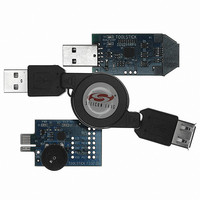TOOLSTICKSK Silicon Laboratories Inc, TOOLSTICKSK Datasheet - Page 7

TOOLSTICKSK
Manufacturer Part Number
TOOLSTICKSK
Description
KIT STARTER TOOLSTICK
Manufacturer
Silicon Laboratories Inc
Series
ToolStickr
Type
MCUr
Datasheet
1.TOOLSTICKSK.pdf
(18 pages)
Specifications of TOOLSTICKSK
Contents
Base Adapter, C8051F330 Daughter Card and USB Cable
Interface Type
USB
Operating Supply Voltage
2.7 V to 3.6 V
Accessory Type
Starter Kit Adapter
Convert From
USB
Convert To
Daughter Board
Development Tool Type
Hardware - Daughter Card
Mcu Supported Families
ToolStick C8051F330
Rohs Compliant
Yes
Lead Free Status / RoHS Status
Contains lead / RoHS non-compliant
For Use With/related Products
C8051F300
Lead Free Status / Rohs Status
Lead free / RoHS Compliant
For Use With
C8051F330
Lead Free Status / RoHS Status
Lead free / RoHS Compliant, Contains lead / RoHS non-compliant
Other names
336-1348
6.2. Connecting to the Device and Downloading Firmware
This section describes how to open the IDE, open and build a project, connect to a device and download the
firmware.
1. Open the Silicon Laboratories IDE from the Start → Programs → Silicon Laboratories menu.
2. In the IDE, go to Project → Open Project.
3. Browse to C:\SiLabs\MCU\ToolStick\F330DC\Firmware\.
4. Select F330DC_FeaturesDemo.wsp and click OK.
5. In the IDE, select Project → Rebuild Project.
6. Go to Options → Connection Options.
7. Select “USB Debug Adapter” for the Serial Adapter and “C2” for the Debug Interface, and then click “OK”.
8. Go to Debug → Connect.
9. Download the code using the download button on the menu bar or use alt-D.
Once these steps are completed, the firmware is built into an object file (step 5) and downloaded to the device
(step 9). The device is now ready to begin executing code. If all of these steps were followed successfully, the “Go”
option is enabled in the Debug menu. A green circle icon in the IDE toolbar also indicates that the device is ready
to run. If one of the steps leads to an error, make sure that the ToolStick is properly inserted in a USB port and start
again with step 6.
6.3. Running and Stopping Code Execution
Once the IDE is connected to the device and the firmware is loaded, the IDE can start and stop the code execution.
The following steps can be performed using the buttons on the toolbar or using the options in the Debug menu.
1. To start code execution, click the green “Go” button on the toolbar or use the Debug → Go menu option. The
2. To stop code execution, click the red “Stop” button on the toolbar or use the Debug → Stop menu option. The
All debug windows and watch windows are refreshed when the device is stopped. If any of the values in these
windows have changed since the last time the device was halted, the new value is shown in red text instead of
black text.
green LED on the daughter card will start to flash. The debug commands in the IDE (single-step, multiple-step,
set breakpoint, and others) are disabled when the device is running. While the firmware is running, the
potentiometer on the daughter card can be turned to alter the blinking speed of the LED.
device will halt code execution and all of the registers and pins on the device will hold their state.
Rev. 0.3
ToolStick-F330DC
7












